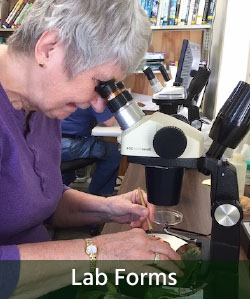
“Your explanation was spot on. Suggested sprays did the job. Pests are gone. I will use this service again and recommend to neighbors and friends. Thank you.” “I was very satisfied with the service, and the helpful attitude of staff I dealt with. I expected that the samples I submitted would show a fungus infection, but the report was negative…” “Read all reports. Basically said to wait it out and plants would come back on their own. I just cut out all of the dead stuff and let them grow. Four out of five are growing back–one barely growing. Information was helpful overall. Would recommend to others. Thanks!” |
||
Diagnostic Lab
Where samples submitted by residents are analyzed
The Fairfax County Master Gardeners operate an award-winning diagnostic laboratory year-round. This unique service is staffed by senior Master Gardeners who have many years of experience in solving plant, pest, and disease problems.
Residents submit sample(s) of pests, diseases, or unhealthy materials to the lab for identification and treatment recommendations. Plant sample are also submitted for simple identification too.
Submit a sample
At this time there are two ways to submit your sample. Emailing photos of your sample directly to the lab email address or bringing your sample to one of the Plant Clinics at select Fairfax County Farmers Markets. (Annandale, Herndon, Lorton, Lorton Workhouse Community, McLean, Reston, and Wakefield) operated from May through September.
Submitting samples through the Fairfax County Library or directly to the Help Desk located in the Virginia Cooperative Extension Office are not supported at this time.
Samples sent as photos should be submitted by following the Instructions for Submitting Photo Samples which are found on the Request Forms used to document your question. The link for the Request Forms is found on the left hand side of this page. There is a Request Form for Identifying Plants, Identifying Insects and Diagnosing a Problem with a plant/tree/lawn. Please use the one(s) most appropriate for your question.
Your sample will be analyzed at the Lab and a detailed diagnosis with recommendations will be emailed or mailed to you. This may take up to 2 to 4 weeks, depending on the time of year and the backlog of requests. Usually the turn-around time is much less.
Samples which are brought to the Fairfax County Farmers Markets’ Plant Clinics are delivered directly to the laboratory by the Plant Clinic Volunteers. Plant specimens should be sealed in a plastic bag, insects in a firm plastic container. Complete the Laboratory Diagnostic Sheet, and place the sheet and the plastic container in another envelope or box. Do not place the Lab Sheet inside the same plastic bag with the sample. (Moisture from the sample often renders the sheet unreadable.)
Collecting and packing samples
For disease/problem diagnosis
Provide a sample showing both diseased and healthy tissue on the same sample. For proper diagnosis, samples should have stems or branches 6″ long or longer. Individual leaves are usually not sufficient. Include a small handful of fine feeder roots if you think the plant can spare them.
For plant identification
Provide as many parts of the plant as possible – the entire plant if it is small enough. In addition to stems and leaves, include flowers or berries if available. Attach a description of the plant’s size, shape and growing habits. For example, does it drop its leaves in winter, is it a 5-foot shrub or a 1-foot groundcover, etc. If no flowers are available, describe when it last flowered and what kind of flowers it had.
For Sod
Submit a sample of sod 6-inch to 8-inch square from the margin of the affected area that contains both healthy and problem grass. Do not send grass that is already dead. Send the entire root system – it may be 2 or 3 inches deep. Place sod it a plastic bag inside a sturdy box. For identification of a lawn weed, do not send sod but follow instructions above for plant identification.
For Insects
Collect one or more complete insect specimens and place them in a sturdy plastic container, such as old pill bottle or film canister, with diluted rubbing alcohol. Soak insects overnight to preserve them, then drain off ALL the alcohol and seal. Do this BEFORE you bring the sample to the library. Do not send insects in tissue paper or envelopes. Do not tape insects to a card or paper.